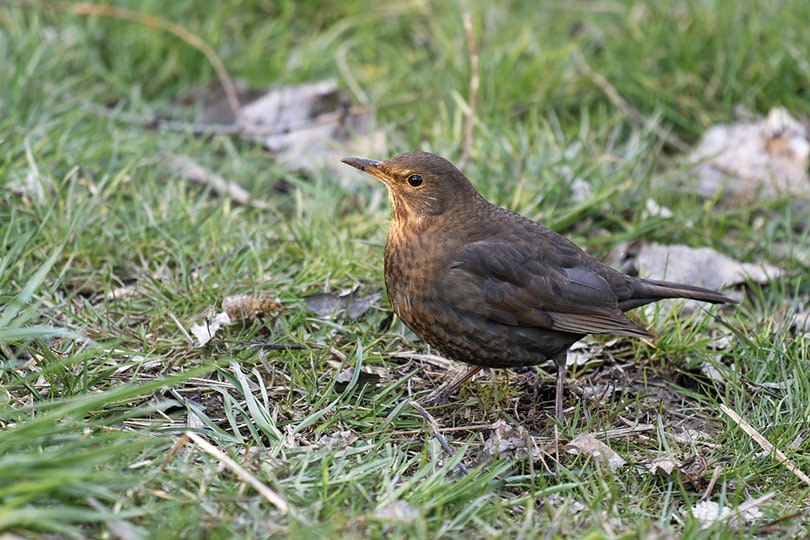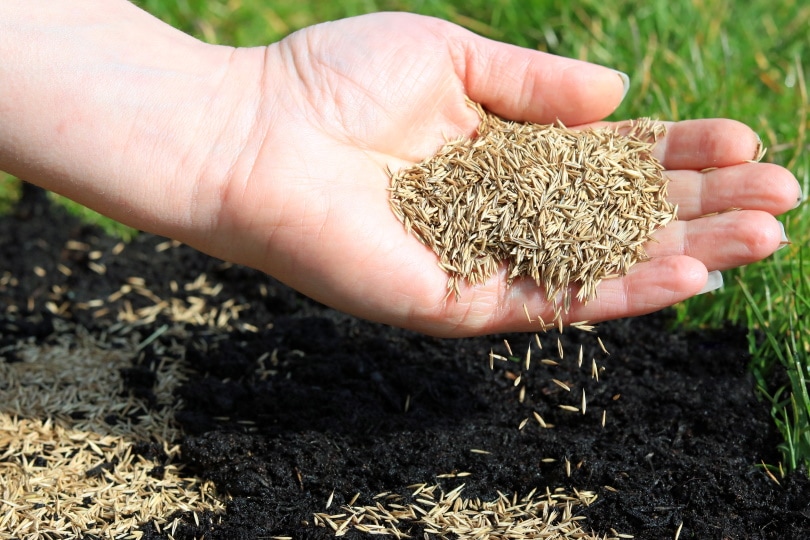How To Stop Birds Eating Grass Seed (11 Proven Methods)
Last Updated on

Whether you’re planting a lawn at a new home or replacing the turf in your yard, growing new grass can be more complicated than it seems. A lawn can grow without disruptions in perfect conditions, but few homeowners live in areas without wind, harsh weather, or wildlife. Heavy rains followed by high temperatures can cause some seeds to rot before germinating, and the wind can move others away from the planting area. Although you cannot protect your seeds from every threat, you can keep birds from consuming your immature grass with these suggestions.

The 11 Best Ways to Stop Birds Eating Grass Seed
1. Mulch
Mulch keeps plants cooler in high temperatures, inhibits weeds, and maintains moisture. Gardeners and homeowners use several mulches depending on the project, and you can find pine bark, plastic, paper, and wood chip mulch in most garden centers and online retailers. However, for grass seeds, you’ll need straw mulch. You only need to apply a thin layer over the seeds to deter the birds. A thick layer of mulch is ideal for shrubs and plants, but grass seeds need thin coverage to allow sunlight in. Mulch is denser than straw, so it’s less likely to blow away in light winds.

2. Straw
Covering your seeds with straw is one of the most affordable methods to keep birds away. Scatter a thin layer over the seeds and avoid overlapping the pieces too much so the grass still receives plenty of light. If you experience heavy winds in your area, straw is not the best covering. It blows away quickly, but it’s inexpensive to replace.
3. Protective Netting
Fastening protective netting over the growing area with stakes will prevent the flying poachers from stealing your seeds. It’s not the most attractive option if you use black nets, but you can also find green ones that blend in with the environment. Bird nets are inexpensive when you buy them online, and they last for several seasons if they’re removed and stored in a dry area.
After the seeds germinate, you can use the same net to protect small fruit trees and bushes from the birds. However, the plastic must be fastened near the bottom of the trunk to prevent entry. Some birds will become trapped if they come in from the bottom and try to fly out of the net.

4. Feeding Stations
You can keep a flock away from your grass seeds by setting up bird feeders around your yard. Try to install them several feet from your growing site. If it’s too close, some birds will get bullied away from the feeder by dominant species and choose your lawn as an alternative. Birds of all sizes like grass seeds, and you can satisfy different species by filling the feeders with other nuts, seeds, and fruit.
5. Fake Owls
Owls seem wise and relatively calm to most humans, but they’re not loved by smaller birds. Owls have varied diets, but most will hunt birds, eggs, and hatchlings. If you place a fake owl near the grass patch, it may convince the birds to find food elsewhere. However, some intelligent birds may know the difference between a plastic owl and their real arch enemy. The scarecrow technique does not work with all birds.

6. Reflective tape
Birds dislike reflective material because it interferes with their vision when they transition from flying to perching. Gardeners often attach the strips to blueberry bushes, but you can fasten them to plastic stakes, rebar, or wooden posts to disrupt the birds’ landing at the growing site. They’re less effective in calm conditions but ideal for windy areas. Garden centers and online shops carry reflective tape.
7. Burlap
Another cost-effective solution is to use burlap. It’s easy to cut, and you can fasten it to the ground with stakes to protect it from the wind. Burlap allows water and light in, but it’s durable enough to keep most birds from pecking through. However, a determined bird with a strong beak, like a blue jay, may be bold enough to poke holes in the material. Burlap is inexpensive and effective, but you may have to remove it after heavy rains to prevent mold from developing.

8. Motion-Activated Sprinklers
If you have clever birds visit your yard that can evade your ground covering, you can set up motion-activated sprinklers to push them away. The only downside to the sprinklers is keeping your water turned on all day. If your hoses are durable and all the connections are tight, you should not have any problems, but a small leak can increase your water bill.
9. Extra Seeds
Covering the seeds usually keeps birds away, but many homeowners do not like having their front yard covered with burlap, straw, or plastic netting. A simple alternative to covers is to lay down more seeds. The birds can enjoy a snack, and your seeds will still germinate. However, a large group of birds that visit daily can thin your supply quickly, and you may have to resort to deterrents or coverings to keep them away.

10. Bird Resistant Seeds
Manufacturers produce bird-resistant seeds that you can use to minimize your losses when birds visit to feed. Some species can overcome the taste of the protective coating, but most birds will choose to find seeds in another location. The coating is not harmful to birds but makes them taste unpleasant.
11. Noise Makers
Instead of using motion-activated sprinklers to repel the avian threat, you can install noise deterrents. Some models run on batteries, but you can spend a little more on a solar model. You can find units that make audible noises and ones that rely on ultrasonic sounds. Ultrasonic deterrents are made for birds, insects, rodents, and other wildlife, but their use is controversial. Some gardeners have success with the devices, but they do not seem to work for everyone.


Conclusion
Why do birds eat grass seed? It’s a filling snack loaded with fat, but it’s not the only part of an avian diet. You can encourage the birds to move away from your lawn with treats like unsalted peanuts, dried fruit, thistle, cracked corn, and dried mealworms. Keeping winged invaders away from your grass seeds is critical because some birds that do not eat the seeds will play in the fine dirt and disrupt germination. Outwitting the birds is not difficult, but you may have to try several methods before they find another lawn to disturb.
You might also be interested in: 14 Birds That Eat Mosquitoes and Bad Garden Bugs (With Pictures)
Featured Image Credit: Surprising_Shots, Pixabay
About the Author Robert Sparks
Robert’s obsession with all things optical started early in life, when his optician father would bring home prototypes for Robert to play with. Nowadays, Robert is dedicated to helping others find the right optics for their needs. His hobbies include astronomy, astrophysics, and model building. Originally from Newark, NJ, he resides in Santa Fe, New Mexico, where the nighttime skies are filled with glittering stars.
Related Articles:
How to Collimate Binoculars: 9 Expert Tips
How to Clean a Refractor Telescope: Step-by-Step Guide
How to Clean a Telescope Eyepiece: Step-by-Step Guide
How to Clean a Rifle Scope: 8 Expert Tips
Can You Use Binoculars to Look At Stars? How to Choose the Right Pair
How to Choose Binoculars for Bird Watching: 10 Expert Tips
Monocular vs Telescope: Differences Explained (With Pictures)
What Is a Monocular Used For? 8 Common Functions
